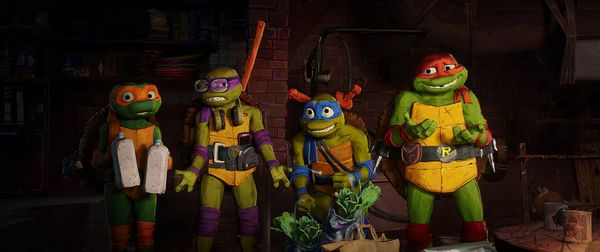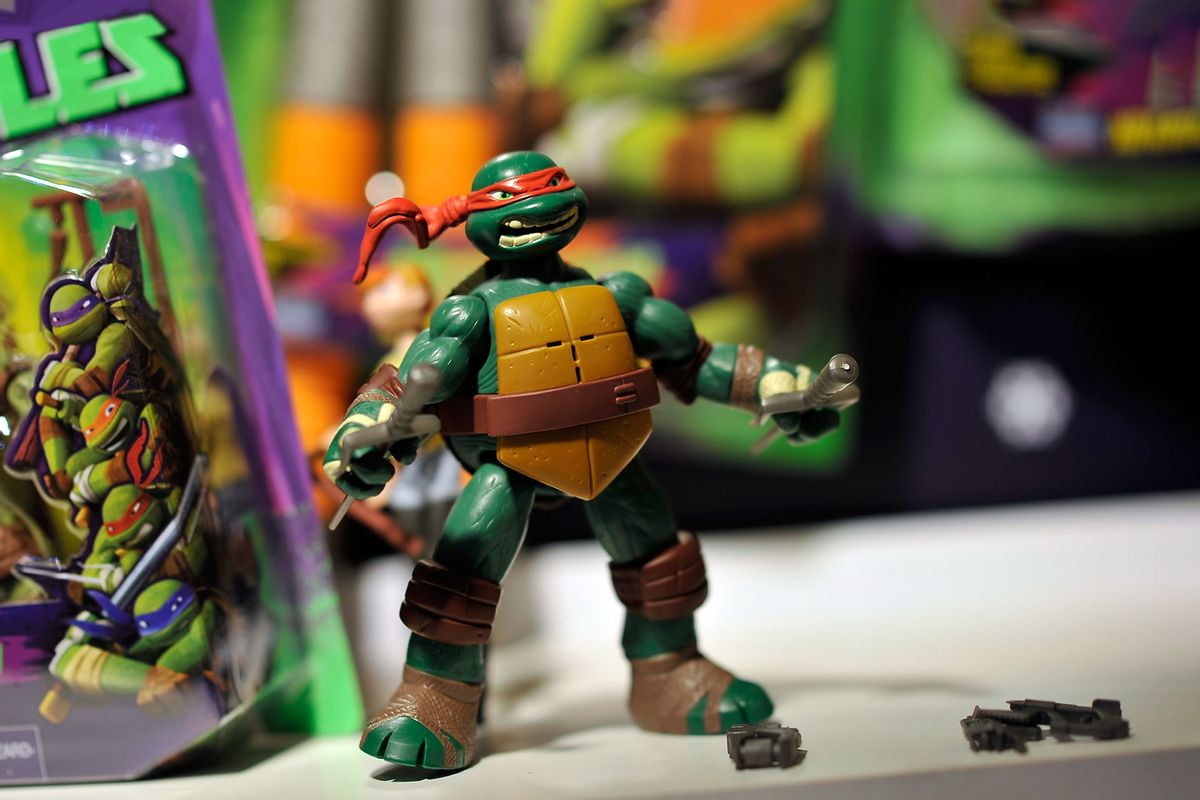In 1987, when "Teenage Mutant Ninja Turtles" first aired in syndication as a five-part animated miniseries, it served as the perfect advertising for a line of action figures and accessories to be released in conjunction, which was the name of the game at this time. Based on characters first introduced in thematically darker comic books created by artists Kevin Eastman and Peter Laird in 1984, the show built off of the original concept of four baby turtles who — with the help of a little radioactive ooze — morph into walking, talking, crime-fighting martial arts experts and ran with it all the way to the bank, much to the delight of young Gen Xers looking to pair their well-loved He-Man and G.I. Joe toys with capable new opponents.
You'll never forget the feel of the toys. You can't buy marketing like that these days.
Eastman and Laird's core characters Leonardo, Raphael, Donatello and Michelangelo did not start off as family-friendly. They cursed, drank and exacted vengeance in ways far more gruesome than what would be deemed acceptable for children. It wasn't until they sold the rights to Playmates Toys in the '80s, who insisted on promotion via cartoons, that the turtles' edges began to soften, both figuratively as well as literally. In the original comics — which you can purchase or re-purchase on Ebay or elsewhere now for hundreds of dollars in mint condition — they're frightful, frowny creatures. But with some toy money behind them, they became colorful, smirking chonky little things that jumped easily off the screen into blister-packed articulation, finding their way under Christmas trees and into birthday wrapping paper for years to come.
Between 1988 and 1992, 1.1 billion of Turtles toys were sold, according to ye olde Wikipedia, making them the third-bestselling toy figures ever at the time, just behind "G.I. Joe" and "Star Wars." But what sets the Ninja Turtles toys apart from other popular ones from that era is that the toy itself was just as culturally valuable, if not more, than the content it was based on, due in large part to the tactile feel of them. Heavy, durable plastic that you can touch and be transported to a time when it was less of a concern as to whether their heft would injure someone when used to bonk them in the head.
Even if you're a fan, you may struggle to recall much from the cartoon series and live-action films that followed, beyond their "Cowabunga" catchphrase and countless mentions of pizza, but you'll never forget the feel of the toys. You can't buy marketing like that these days, though efforts are certainly made. There's just less of a market for physical stuff now where, back then, "stuff" filled a lot of holes. For kids of the early '80s and '90s, an action figure took on a lot of different roles. They were our buddies. Lures for getting or keeping friendships. And, in a way, de-facto babysitters standing between the safety of a bedroom and the stranger-danger we were made to feel was always lurking just outside the confines of our homes. Mostly though, they just felt cool and didn't attract fuzzies and pet hair like some other sticky-legged, high-arched toys recently resurrected in pop culture's spin of the wheel. *cough cough* Looking at you, Barbie.
Want a daily wrap-up of all the news and commentary Salon has to offer? Subscribe to our morning newsletter, Crash Course.
On the raised heels of the record-breaking release of Greta Gerwig's "Barbie," which brought about a resurgence of toy and accessory mania not seen in quite this way for a long, long time, Leonardo, Raphael, Donatello and Michelangelo are also making a comeback with the release of "Teenage Mutant Ninja Turtles: Mutant Mayhem." Seth Rogen, who co-produces the film and also helped to write it, adds to the lightheartedness of the characters established in the late '80s, putting his specific comedic spin on things in a way that appeals to audiences of all ages. With more adult-themed animation such as "South Park" and "BoJack Horseman" sustaining popularity over the past 30 years or so, cartoons are no longer seen as something that's just for kids. And neither are toys.
 Mikey, Donnie, Leo, and Raph in "Teenage Mutant Ninja Turtles: Mutant Mayhem" (Paramount Pictures )
Mikey, Donnie, Leo, and Raph in "Teenage Mutant Ninja Turtles: Mutant Mayhem" (Paramount Pictures )
When I first heard that there was going to be a new Ninja Turtles movie, the first thing that came to mind was the potential for a new series of action figures based on characters now voiced by a new generation of young actors as the turtles, along with Ayo Edebiri as April O'Neil, Hannibal Buress as Genghis Frog, Rose Byrne as Leatherhead and Rogen himself as the voice of Bebop, a mutant warthog — whose original action figure was one of my favorites as a child.
Appearing on shelves in mid-June, the new Ninja Turtles action figures have the signature Playmates Toys seal and are in keeping with the original character's color-schemes and trademark weapons, with noticeable modernizations. Donatello comes with removable thick-framed black glasses and headphones. Michelangelo is ganglier in his teen articulation, with an ear-to-ear grin painted on his face. And the character's eyes seem further apart. All details that wouldn't stand out so noticeably had you not spent a good portion of your formative years playing with much (MUCH) older versions.
"Cowabunga" is a frame of mind.
A week or so ago, while grocery shopping at a big box store, I took a detour past the food aisles and headed to the toy section in hopes of getting a look. Parking my cart at the end and elbowing my way past a group of young boys to see these new Turtles, I spotted the familiar packaging right away.
"They're here!" I said out loud, surprising the youths around me, now that weirdo at the store that I delighted in making fun of at their age.
As my eyes went from box to box and character to character, I made the decision to not grab a few off the shelves, because I was overtaken with that "They're not the same" feeling. This gut reaction will, most certainly, not stop me from going back at my earliest convenience to stock up, provided there are any left.
Things can't stay the same. That's kind of the point. And while I miss the feel of those original turtles, and regret that they, at some point or another, found their way to some Goodwill or another, as most childhood toys do, those kids standing by me in the aisle that day may be forming their relationships with the figures as they look and feel today, for the very first time. And they're in for a treat, with nothing better or different to compare them to — unless they can convince their parents to cough up big bucks online for the originals, which I'm also seriously considering doing. "Cowabunga" is a frame of mind, is a thing I'll tell myself when clearing space in the area of my office where I keep all my little collections. Nostalgia is just a sweaty-palmed debit card swipe away.
Read more
about this topic



Shares